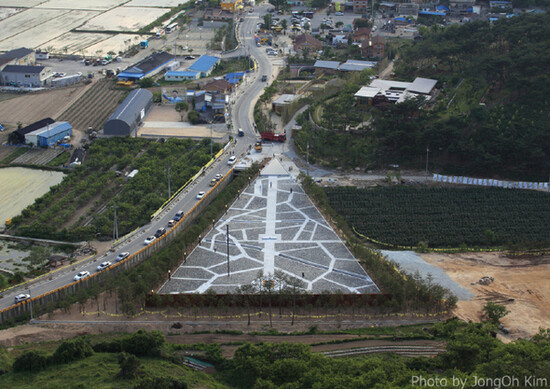hankyoreh
Links to other country sites 다른 나라 사이트 링크
Do western architects disrespect eastern architecture?

By Goo Bon-joon, staff reporter
“Bonghwa Village Graveyard,” the burial ground of late President Roh Moo-hyun, will be introduced at the International Architecture Exhibition of La Biennale di Venezia, international architecture’s biggest celebration. Seung Hyo-Sang, president of the IROJE architectural firm and the only Korean architect invited to the exhibit, will address global architecture experts on the grave he designed.
This year’s exhibit, themed “Common Ground,” examines common elements in architecture. In line with this theme, Seung selected 10 of the homes he designed and will explain the context of commonality within them. Why did he include a grave among them?

“Bongha Village Graveyard is a ‘home for a dead person,’ but has some things in common with the home of a living person. I selected it as the work in an attempt at ‘construction of emptiness,’ which we have inherited from Korean traditional architecture and I have attempted in modern architecture.”
A feature of Korean traditional architecture is that it does not seek to build a building, a structure itself, but rather tries to connect organically the inside and outside by leaving part of the structure empty. To continue this as modern architecture is the “construction of emptiness” philosophy espoused by Seung. The graveyard is wide, but the grave itself has been minimized, and the graveyard, which harmonizes and becomes one with the natural scenery, is an illustration of this philosophy.
The International Architecture Exhibition of La Biennale di Venezia is divided into National Participations, in which each nation directly selects architects who display their architectural discourse, and a themed exhibit in which the hosts directly select and invite the architects. The themed exhibit is the highlight of the Biennale as it focuses on the most famous and distinguished modern architects.
Seung, who is the third Korean architect ever selected and the only one to get invited twice, says he hesitated to participate in the Biennale. This is because of the 64 star architects invited, there were only two from Asia: Seung and Japanese architect Kazuyo Sejima. “I thought the European architecture world doesn’t respect Asian architecture. After hesitating, I decided to go and discuss Asian architectural values that aren’t found in Western architecture.”
Accordingly, the message he tries to convey through his 10 homes is the issue of the ethics of architecture. Seung plans to explain the differences between Western and Eastern architecture by comparing Gyeongju’s Dongnakdang Hall (the men‘s quarters of Yi Eon-jeok’s home built in 1516), a classic masterpiece of Korean architecture, and the Villa Rotonda, a classic among classics of Western Renaissance architecture.
“The Dongnakdang Hall is a solitary house that takes delight in its being left alone, while harmonizing with the surroundings. The Villa Rotonda is a house that dominates its surroundings alone. Modern architecture is now stuck on the Villa Rotonda, a symbol of Western architecture. I think it’s time to take a look back at the ethical architecture pursued by the Dongnakdang Hall.”
Please direct questions or comments to [english@hani.co.kr]

Editorial・opinion
![[Column] Season 2 of special prosecutor probe may be coming to Korea soon [Column] Season 2 of special prosecutor probe may be coming to Korea soon](https://flexible.img.hani.co.kr/flexible/normal/500/300/imgdb/original/2024/0426/3317141030699447.jpg) [Column] Season 2 of special prosecutor probe may be coming to Korea soon
[Column] Season 2 of special prosecutor probe may be coming to Korea soon![[Column] Park Geun-hye déjà vu in Yoon Suk-yeol [Column] Park Geun-hye déjà vu in Yoon Suk-yeol](https://flexible.img.hani.co.kr/flexible/normal/500/300/imgdb/original/2024/0424/651713945113788.jpg) [Column] Park Geun-hye déjà vu in Yoon Suk-yeol
[Column] Park Geun-hye déjà vu in Yoon Suk-yeol- [Editorial] New weight of N. Korea’s nuclear threats makes dialogue all the more urgent
- [Guest essay] The real reason Korea’s new right wants to dub Rhee a founding father
- [Column] ‘Choson’: Is it time we start referring to N. Korea in its own terms?
- [Editorial] Japan’s rewriting of history with Korea has gone too far
- [Column] The president’s questionable capacity for dialogue
- [Column] Are chaebol firms just pizza pies for families to divvy up as they please?
- [Column] Has Korea, too, crossed the Rubicon on China?
- [Correspondent’s column] In Japan’s alliance with US, echoes of its past alliances with UK
Most viewed articles
- 1Is Japan about to snatch control of Line messenger from Korea’s Naver?
- 2Up-and-coming Indonesian group StarBe spills what it learned during K-pop training in Seoul
- 3‘We must say no’: Seoul defense chief on Korean, USFK involvement in hypothetical Taiwan crisis
- 4[News analysis] Using lure of fame, K-entertainment agency bigwigs sexually prey on young trainees
- 5[Column] Park Geun-hye déjà vu in Yoon Suk-yeol
- 6Is N. Korea threatening to test nukes in response to possible new US-led sanctions body?
- 7Korea’s 1.3% growth in Q1 signals ‘textbook’ return to growth, says government
- 8Division commander ordered troops to enter raging flood waters before Marine died, survivor says
- 9Report reveals toxic pollution at numerous USFK bases
- 10[Editorial] Statue should not be central concern of comfort women issue